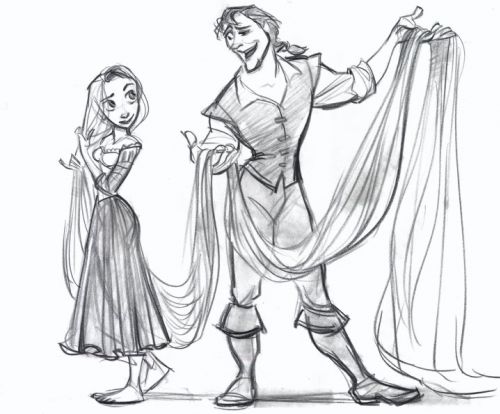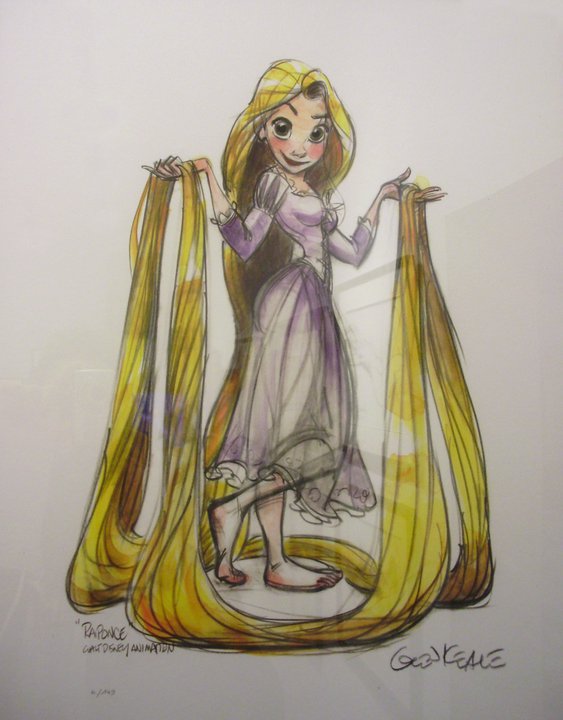Clothes for the princess
How the laws of physics helped create the outfit for the new Disney star.

Quite often, we observed a mismatch of the movements of the drawn characters with the movements of a real person, violations of the laws of physics, but all this is in the past. Legacy technologies are being replaced by new ones that help in creating perfect characters, perfect movements and ... Even the clothes of the heroes now, like reality, lend themselves to the laws of physics, taking into account friction and elasticity.

When the animators at Ulta Disney Studios first dressed Rapunzel in a dress and began to rotate it in front of a mirror, she froze in a half-turn position, and the folds of her dress lay like a shell. The creators of the film faced a difficulty that had long tormented animators, costumers.
“We decided to create a more sophisticated robe than previously possible using computer graphics,” explains Rasmus Tamstrof, a Walt Disney group researcher. “But when a character in a free multi-layered outfit moves, different layers of fabric can come into contact, especially when they slide one on the other.” And it can cause difficulties. ”
“We decided to stop being afraid of difficulties and try to go where the directors took us,” adds Steve Goldberg, senior visual effects specialist, a Disney veteran with 20 years of experience. “In computer animation, the notion of what is difficult and what is easy is changing very quickly. What seems impossible on one film is done without problems on the next. The technology is developing rapidly, and in each picture we gain experience, thanks to which we move forward. "

Instead of tempering their aesthetic needs or attracting an army of animators to handle complex scenes manually, as cartoon creators usually do, Tamstrof and his team decided it was time to find a new way to solve the problem.
They contacted computer professional Eitan Greenspoon. He became interested in this area in 2002 when he “animated” a cowboy hat falling and jumping on the floor. He spent hours studying the slow-motion frames of the film and eventually found the simplest equation for expressing the interaction of variables that affect the hat rebound. And they included friction, elasticity (flexibility) and the moment of momentum with which it hit the floor. Eitan then translated his equation into simple computer code that can be used for any “flexible material,” including rubber, fabrics, and even metal sheets.
However, portraying the movements of an unusual princess dress is a difficult task. In the case of multi-layer clothing, the computer must take into account thousands of possible simultaneous touches. When the animation program is overloaded with data, it turns to the backup (protective, fail-safe) program, which does not allow layers of fabric to create new touches.
Previous such programs continued the movement of the fabric, but did not allow mutual movements of the layers, which created the impression of rigidity.

A few months later, the team found a solution. They resigned themselves to the need for a protective program that prevents new contacts, but their program allowed the sliding of several layers and took into account friction, which determines the speed of such sliding.
The result was much more realistic. Later, I had to move on to another solution to the problem, developing a program for accurately predicting the movement of hair, which is more complicated than the task with “tissue slipping”.
Senior animator Clay Katies explains: “Previously, no studio had to make 20-meter hair. Typically, hair in a computer animation behaves passively. They do not participate in the lives of the heroes, they are not dismissed throughout the room and are not wrapped around chairs. We were the first to do all this. I am simply shocked by the technical level that we all achieved on this film. This is a real miracle of technology. ”

To solve this problem, it was also necessary to attract specialists.
Ward, a computer engineer, was part of a group of three people (besides her, Marianne Simmons and Andy Milne), who were tasked with developing hair modeling software. And this is no coincidence: Ward defended her thesis on her hair and spent the last 10 years searching for the best way for their computer animation. She is considered perhaps the best specialist in this field.
Gathering information, engineers watched shampoo commercials on
YouTube and watched a model with 2-meter-long hair. Many tests have been done so that the modeling programs best convey the movement of hair.
“After we realized that we could model hair, we had to take into account a bunch of director's instructions about all the contours, bends of the hair, about their movement and weight. The main thing was to learn to do it quickly and without losing control. At the beginning of work, it took us two weeks for one shot; later we reduced this time to 10 hours, ”says one of the specialists, later the team added finishing touches to Rapunzel’s hair, giving it a magical shine.

So that we can see the masterpieces of world animation, thousands of people do a great job, and you thought that cartoons are easy? :)

Quite often, we observed a mismatch of the movements of the drawn characters with the movements of a real person, violations of the laws of physics, but all this is in the past. Legacy technologies are being replaced by new ones that help in creating perfect characters, perfect movements and ... Even the clothes of the heroes now, like reality, lend themselves to the laws of physics, taking into account friction and elasticity.

When the animators at Ulta Disney Studios first dressed Rapunzel in a dress and began to rotate it in front of a mirror, she froze in a half-turn position, and the folds of her dress lay like a shell. The creators of the film faced a difficulty that had long tormented animators, costumers.
“We decided to create a more sophisticated robe than previously possible using computer graphics,” explains Rasmus Tamstrof, a Walt Disney group researcher. “But when a character in a free multi-layered outfit moves, different layers of fabric can come into contact, especially when they slide one on the other.” And it can cause difficulties. ”
“We decided to stop being afraid of difficulties and try to go where the directors took us,” adds Steve Goldberg, senior visual effects specialist, a Disney veteran with 20 years of experience. “In computer animation, the notion of what is difficult and what is easy is changing very quickly. What seems impossible on one film is done without problems on the next. The technology is developing rapidly, and in each picture we gain experience, thanks to which we move forward. "

Instead of tempering their aesthetic needs or attracting an army of animators to handle complex scenes manually, as cartoon creators usually do, Tamstrof and his team decided it was time to find a new way to solve the problem.
They contacted computer professional Eitan Greenspoon. He became interested in this area in 2002 when he “animated” a cowboy hat falling and jumping on the floor. He spent hours studying the slow-motion frames of the film and eventually found the simplest equation for expressing the interaction of variables that affect the hat rebound. And they included friction, elasticity (flexibility) and the moment of momentum with which it hit the floor. Eitan then translated his equation into simple computer code that can be used for any “flexible material,” including rubber, fabrics, and even metal sheets.
However, portraying the movements of an unusual princess dress is a difficult task. In the case of multi-layer clothing, the computer must take into account thousands of possible simultaneous touches. When the animation program is overloaded with data, it turns to the backup (protective, fail-safe) program, which does not allow layers of fabric to create new touches.
Previous such programs continued the movement of the fabric, but did not allow mutual movements of the layers, which created the impression of rigidity.

A few months later, the team found a solution. They resigned themselves to the need for a protective program that prevents new contacts, but their program allowed the sliding of several layers and took into account friction, which determines the speed of such sliding.
The result was much more realistic. Later, I had to move on to another solution to the problem, developing a program for accurately predicting the movement of hair, which is more complicated than the task with “tissue slipping”.
Senior animator Clay Katies explains: “Previously, no studio had to make 20-meter hair. Typically, hair in a computer animation behaves passively. They do not participate in the lives of the heroes, they are not dismissed throughout the room and are not wrapped around chairs. We were the first to do all this. I am simply shocked by the technical level that we all achieved on this film. This is a real miracle of technology. ”

To solve this problem, it was also necessary to attract specialists.
Ward, a computer engineer, was part of a group of three people (besides her, Marianne Simmons and Andy Milne), who were tasked with developing hair modeling software. And this is no coincidence: Ward defended her thesis on her hair and spent the last 10 years searching for the best way for their computer animation. She is considered perhaps the best specialist in this field.
Gathering information, engineers watched shampoo commercials on
YouTube and watched a model with 2-meter-long hair. Many tests have been done so that the modeling programs best convey the movement of hair.
“After we realized that we could model hair, we had to take into account a bunch of director's instructions about all the contours, bends of the hair, about their movement and weight. The main thing was to learn to do it quickly and without losing control. At the beginning of work, it took us two weeks for one shot; later we reduced this time to 10 hours, ”says one of the specialists, later the team added finishing touches to Rapunzel’s hair, giving it a magical shine.

So that we can see the masterpieces of world animation, thousands of people do a great job, and you thought that cartoons are easy? :)
